
Should You Veer for Deer?
After a recent spate of wildlife collisions on Ontario’s roads, it’s a good time to review some strategies to avoid hitting deer and other wildlife while behind the wheel.
Deer collisions happen year-round, but according to the Canada Safety Council, they “peak in October and November, which is the mating season and the time for migration to winter living areas.” Dawn and dusk are prime time for animal movement, and the fading daylight at this time of year doesn’t help–especially when Ontario turns back its clocks on November 1st.
According to the Wildlife Collision Prevention Program, animal-vehicle collisions predictably take place in four settings: where creeks and drainages intersect roads, where there is good habitat and forage near the roadside, where there is a water source nearby, and on long, wide, straight stretches of road.
When you’re driving, if you spot a deer on the road ahead, keep the OPP slogan “Don’t Veer for Deer” in mind.
Don’t swerve to try to miss it. Rather, slow down quickly and steer straight ahead. OPP Inspector Dave Towell explains that “by changing your direction quickly, you increase the risk of losing control, running off the roadway and rolling your vehicle. This increases the likelihood of sustaining greater damage to your vehicle and serious injury.”
When you spot a deer on the road, stay alert and slow down as much as possible. You can turn on your flashers to alert other drivers to the potential danger, and sound your horn in short bursts to try to frighten the animal off the roadway. Be aware that deer travel in groups and there are very likely more of them nearby.
Keeping an eye out for all wildlife–whether big or small–on the road is important. Even though a collision with a small animal isn’t likely to cause significant damage to your vehicle or harm its occupants, it can startle you. This may contribute to temporarily losing control of the vehicle or become distracted to the point of inattention to your surroundings.
Kelly Wallace of Think Turtle Conservation Initiative suggests having others in your vehicle help with the task of scanning the area for animals. “Enlist your passengers help to actively watch for wildlife – on the road, in the ditch, on the shoulder, and in the right of way. The presence of wildlife is part of what makes Ontario a wonderful place to call home and visit.”
The Canada Safety Council says that lack of attention and excess speed are the two major causes of wildlife collisions, and that the best way to avoid them is to drive defensively. This “involves driving at appropriate speeds where you’ll be able to stop if needed, leaving space around your vehicle in case something suddenly encroaches on your space, and keeping a constant scan of the road.”
